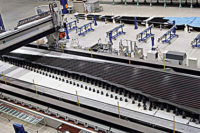Large companies and small towns are sometimes a perfect fit. The most well-known example of this is Wal-Mart Stores Inc., which is the world’s largest retailer but is headquartered in tiny Bentonville, AR (population: 35,000). Much less known is the pairing of Indar Electric S.L. (a leading global manufacturer of rotary electrical machinery) and Beasain, a town of about 14,000 in the Basque province of northern Spain.
For many of Indar’s 76 years in business, it has been headquartered in Beasain. There, the company operates a large, state-of-the-art production facility that produces generators for the wind industry, as well as hydro generators and electric propulsion motors for large vessels and yachts.
About two years ago, Indar engineers began looking for a way to more precisely track the speed and position of the motor shaft. Indar’s first choice was encoders from Leine & Linde AB (LL, based in Strängnäs, Sweden), having used both the 862 and 865 series in different motors over the years. After meeting with LL, the company decided to try its 2000 series magnetic encoder ring.
Developed in late 2012, the ring is made of lightweight aluminum and has an anodized surface for use in saltwater environments. It is bearingless and comes in two segments for easy transport, storage and access during and after assembly.
During assembly of the propulsion system, workers mount the ring directly to the motor shaft, which is connected to the propeller. Fixing the ring to the shaft can be done with a flange expansion using axial screws, or with LL’s ClampFit system. The latter lets assemblers screw the segments together directly around the shaft without a flange. It also simplifies and quickens commissioning (test verification) of the motor.
Scanning units, each housing a sensor, are positioned and fixed at both sides of the ring, up to 2.6 millimeters from the ring edge. These air gaps permit thermal expansion and runout of the shaft. They also ensure that the sensors remain unaffected by powerful shocks and vibrations during motor operation to provide constant feedback about the shaft’s speed and location.
The sensors send incremental signals via standard interfaces (HTL, TTL and RS422). For long-distance signal transmission, two interfaces (high current HTL and OptoLink) can be used.
“[At the assembly] phase, we realized that this encoder was the only one on the market that would permit an axial displacement [offset] of ±4 millimeters,” says Rocío Ortiz, head of control and instrumentation at Indar. “But, the application also required a redundant signal. At the time, LL didn’t have a magnetic encoder with two scanning heads. They were willing to solve this [problem] by tailoring a solution to our needs.”
Ortiz notes that the encoder’s ability to provide axial displacement is as important during motor startup as when a vessel is at sea. The reason is that the water force creates different loads depending on currents, direction and resistance.
For more information on encoder rings, call 847-490-1191 or visit www.leinelinde.com.



